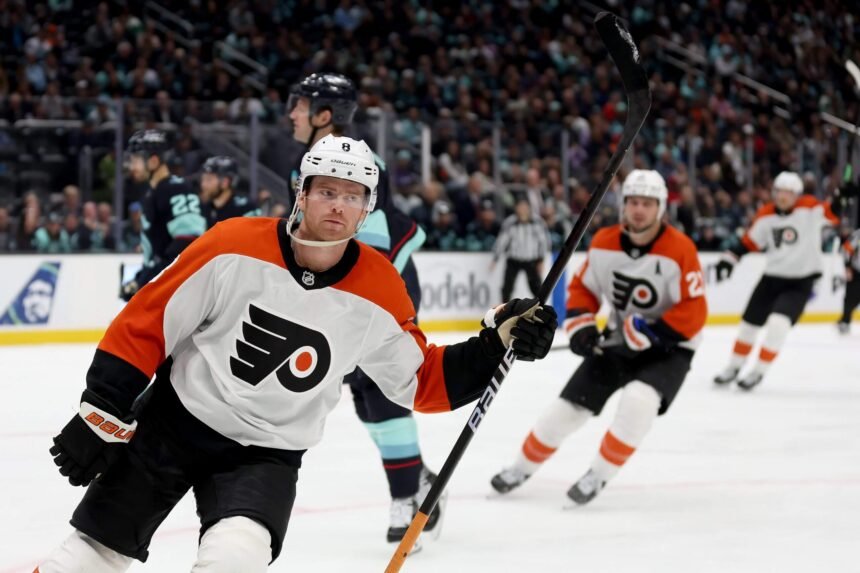When the St. Louis Blues served up dual (dueling?) offer sheets in mid-August to the cap-strapped Edmonton Oilers, targeting two of their young players in Philip Broberg and Dylan Holloway, it was a bombshell day for the NHL.
At the time, there was a debate among executives with other teams over whether either player would be worth his new contract, a debate that has largely subsided given both players’ early play in St. Louis.
Before his injury, Broberg produced nine points in 12 games and had solidified himself as a bona fide top-four defenseman logging 20 minutes a night. And Holloway has established himself as a regular in the top six and “one of the Blues’ top five or six players,” according to our ace St. Louis beat writer Jeremy Rutherford.
In other words, well worth the second- and third-round picks in compensation, and the $6.9 million in salary cap space they’re taking up.
With that as a unique success story, one question our readers had in our latest mailbag callout was: Could this scenario repeat itself again in the summer of 2025? Which restricted free agents might be the best offer sheet targets? And which teams might be vulnerable as the Oilers were to a double- or triple-threat play?
Let’s take a closer look by examining the case for a lot of the top RFAs, and how likely it might be that they can be pried loose by another team.
Tier 4: The bargain buys
This is the level at which the Blues were able to nab Holloway with a two-year contract for just $2.29 million. Next summer, offer sheets of roughly $1.63 million or less against the cap come with no compensation, while those worth $2.4 million or less will result in a third-round pick going to the team losing the player.
It was a bit of a struggle finding RFAs teams would be able to pry loose for such low salaries, as most teams are going to match, but here are some interesting names I came up with.
Again, it’s going to be hard to pry away players at these salary levels. But Jack Quinn and Devon Levi, while top prospects in Buffalo, are having tough years, and perhaps you can make things uncomfortable by offering both more than the Sabres might want to pay them after their entry-level contracts.
The ever-rebuilding Sabres have a ton of cap space, however, so that’s likely going to be more of a nuisance than a success.
Nikolai Kovalenko, Mavrik Bourque and Jonatan Berggren, meanwhile, are all unestablished young players, having played around 120 NHL games combined. Teams could even raise their offer sheet spend outside of this tier if they felt comfortable enough that they were going to be impact players, as very well might be the case with Bourque, who lit up the AHL last season.
With all of the Rangers’ cap headaches related to the Igor Shesterkin contract, I suspect you could sneak Rempe out of there with an offer in the no compensation range. That might be a worthwhile move for a rebuilding team with plenty of cap space that wants to take a flier on the big man and try to develop him into a useful bottom-of-the-roster player.
Pairing these offer sheets with larger ones for players further down this list might make sense, too.
Cam York has become a big-time contributor in Philadelphia, logging 23 minutes a game. (Steph Chambers / Getty Images)
Tier 3: The midlevel targets
This is where the Blues were able to nab Broberg. Next summer, offer sheets between approximately $2.41 million and $4.8 million will require a second-round pick in compensation if successful.
Here are some names that might make for a tough call for their teams at the higher end of that range.
The three young Flyers at the top are all interesting names. Cam York, in particular, has become a big-time contributor in Philadelphia, logging 23 minutes a game, and that alone makes it feel unlikely he would be available without going above this tier.
But Tyson Foerster has struggled mightily early this season, with only three points in 15 games, and his two-way profile should be of a lot of interest to other teams. Morgan Frost, meanwhile, was a John Tortorella healthy scratch just recently and it’s unclear how committed they might be to him on his next contract.
What will work against these offer sheets forcing the Flyers’ hand is that GM Danny Brière has plenty of cap space to work with in the offseason and should be able to match even a triple threat of contracts in July.
The Rangers and Islanders players might be the most effective targets, given those teams’ cap situations. And someone like Alex Laferriere or Ryker Evans could be interesting as they are having breakout seasons at young ages.
Tier 2: The rising stars
Here is where the compensation can start to hurt a little. A successful offer sheet of between approximately $4.81 million and $7.2 million would mean giving up a first- and third-round pick as compensation to the team losing the player.
So, not only do you have to give out a higher salary, you also lose some draft capital that matters a lot more than the picks forfeited for Broberg and Holloway.
Still, there are a lot of interesting candidates here, and contract offers pushing $7 million are going to make things uncomfortable for most of these teams.
Lukáš Dostál is in the midst of a breakthrough campaign with Anaheim, leading the NHL in goals saved above expected as of this writing. And the Ducks are still paying John Gibson a lot of money on his legacy deal.
If Dostál plays enough this season, he could get Vezina votes, which makes him a target for a team looking for a young starting goalie.
What’s interesting about this list, too, is a lot of these teams are going to be dealing with a cap crunch, even under a rising ceiling. I suspect Buffalo and Minnesota don’t hesitate for a second to match anything thrown at JJ Peterka and Marco Rossi (especially with the Wild having plenty of cap space now that those massive buyouts are fading off their books). But can the Rangers really afford a massive offer directed K’Andre Miller’s way with everything else they have to do this offseason?
I doubt it.
The Leafs could be vulnerable with Matthew Knies, who is emerging as a top power forward (230 pounds and climbing) while putting up a 35-goal pace on their top line. Toronto currently has flexibility, but if GM Brad Treliving signs Mitch Marner to a big extension and gets a discount deal done with John Tavares, a lot of that breathing room disappears. They also have some lower level RFAs, such as Conor Timmins, to deal with.

Leafs winger Matthew Knies could be a potential offer sheet target this summer. (Brian Fluharty / Getty Images)
Tier 1: The true superstars
The tough thing when you get to this level of player is their team is almost always going to match an offer sheet. Who wants to lose a superstar for draft picks?
Successful offer sheets of between a projected $7.21 million to $9.6 million are set to come with compensation of first-, second- and third-round picks. Offer sheets of more than $9.6 million (up to $12 million) come with compensation of two firsts, a second and a third-round pick.
Looking at this very short list, it feels likely their teams are going to match offers in the $10 million range. And how much higher would competitors really be willing to go, while also giving up all those picks?
We already know the Oilers are prepared to pay Evan Bouchard eight figures. And I suspect the Islanders are going to have to get close to that for Noah Dobson, too, as uncomfortable as that will be. (Keep in mind that Seth Jones, Zach Werenski and Darnell Nurse are all making in that ballpark using cap percentage.)
Wyatt Johnston is the interesting one, given he’s in only his third NHL season and has one big year under his belt (32 goals and 65 points last season). But his terrific performance in the playoffs last year certainly turned some heads, and there could be teams willing to make him a huge offer if he gets to RFA status on July 1.
The great news for the Stars, however, is GM Jim Nill has done an excellent job with their cap sheet and they have acres of space to work with, especially with Jamie Benn’s contract coming off the books. They should be able to easily match anything thrown at their three main RFAs, with Johnston the No. 1 priority.
Which teams are most vulnerable to offer sheets in 2025?
As hinted at above, the two New York teams stand out the most.
In addition to Shesterkin, the Rangers have useful veterans Ryan Lindgren and Reilly Smith about to become UFAs. They also have four RFAs listed above in this article, meaning the possibility for mixing and matching is there.
Trading away Jacob Trouba will help, but there’s no question they’re vulnerable here if teams get aggressive with players like Will Cuylle, who is having a nice breakout season early on this year and brings the size and playing style so many teams covet on the wings.
As for the Islanders, two of their top veterans in Brock Nelson and Kyle Palmieri are up as UFAs, and three useful RFAs already mentioned in this article. It’ll basically be impossible to return their current roster if they’re targeted with an offer sheet or two — and it’s a lineup that’s struggling to win as it is.
They’ll have to make some uncomfortable decisions even without another team throwing them a grenade to deal with.
Most of the other teams with players listed above can likely match an offer sheet, thanks in part to the fact the salary cap is projected to rise to $92.5 million next season. But the big caveat is that offer sheets often come in after July 1, when teams have already committed to some UFA spending.
The Oilers, for example, signed Viktor Arvidsson and Jeff Skinner for a combined $7 million this past UFA period, and those signings made them far more vulnerable to losing Broberg and Holloway the following month.
Teams with compelling RFAs may have to be more concerned about the offer sheet threat this July, meaning they’ll have to extend their young players sooner or simply leave more cap space available to sign them later in the summer.
It’s possible Doug Armstrong’s bold move last August is going to change the game when it comes to how young RFAs are dealt with going forward.
(Top photo of K’Andre Miller: Bruce Bennett / Getty Images)











